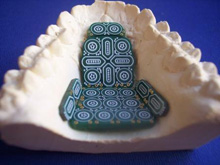Control your computer - using your tongue
One of the severest possible after-effects of a traffic accident is getting a spinal cord injury. In the US, almost a quarter of a million people are paraplegics, while in Denmark the number is ‘only’ 3,000. About half of these are tetraplegics – which means that they are paralysed from the neck down. These people need assistance for everything.
At SMI, Center for Sensory-Motor Interaction, Aalborg University, Denmark, associate professor, PhD Lotte N. S. Andreasen Struijk is working on a project which will hopefully enable these people to independently access the internet and write e-mails and text messages. CISS plays a vital role in the project, which is colloquially known as ‘the tongue project’.
 Keyboard and joystick in one Keyboard and joystick in one
“We use a palatal brace like the one many children have worn if they have had their teeth straightened. Then we apply a series of sensors which the user will be able to activate using the tongue,” Lotte N. S. Andreasen Struijk explains.
“We are working on a model with 18 sensors, of which 10 will be letters – kind of like on a mobile phone. In addition, we will, among other things, have a mouse-pad area which will also function as a joystick. With time, this may come to be used for controlling a wheelchair as well. Our aim is to embed as many features as possible, so each sensor will contain several functions,” she continues.
A matter of size
One of the challenges for the project has been the development of wireless communication and energy supply, and this is where CISS’ expertise has come in handy. Henrik Vie Christensen, chief developer and leader of the new CISS VIP initiative (CISS’ new ‘greenhouse’ for development and innovation of products using embedded software), has been working on these challenges. Since the device needs to fit into the user’s palate, elements like energy efficiency and size have been great concerns, but these seem to have been solved now, Henrik Vie says.
“The electronic systems work, the communication works, and the test software shows us that the signals it produces actually work,” he explains and continues: “We also think we have found someone who will be able to create the batteries we need. It is mostly a matter of size now, both in terms of the electronic circuits and the battery. But we hope to have a prototype ready for testing on intact persons in the autumn of this year.”
Unlimited potential
The project group is working closely together with a panel of users consisting of tetraplegic persons and persons with neuromuscular diseases. “This gives us input as to which elements we should prioritise,” Lotte N. S. Andreasen Struijk says.
“We are all very happy about working on this project, first of all in terms of the potentials – what it may give the users. But we are also happy about our collaboration, with CISS, with TKS A/S (the spin-off company holding the patent for the tongue control system) and with the company Sahva A/S. The collaboration with Sahva has even led to further possibilities; the company has financed a PhD project focusing on the possibility of using our tongue control system for controlling myoelectric arms for people with amputations. So there are almost unlimited possibilities once we get it into production,” Lotte N. S. Andreasen Struijk finishes.
The group hopes to start manufacturing the system sometime in 2009-2010.
|

